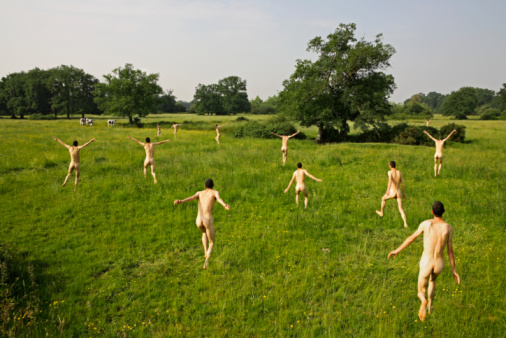Naked Fertility Rituals from Missouri January 8, 2015
Author: Beach Combing | in : Contemporary, Modern , trackbackImagine these three scenes all from Ozark country in Missouri:
A man and a woman walk into a flax field naked chanting, while throwing seeds, ‘Up to my ass, an’ higher too!’ The man throws the seed against the woman’s buttocks. ‘Then they just laid down on the ground and had a good time.’
Date: colonial times (allegedly)
A man takes his wife out to the field ‘He’d make her take off every stitch of clothes and run around the crop three times. And then he would throw her right down in the dirt, and have at it till she squealed like a pig!’
Date 1890s
A man and a woman in Joplin go naked out into a field at 4.00 am, before dawn and begin to chase each other up and down ‘like rabbits’. On the basis of the previous two examples the couple very likely lay down and then had sex, though this is not reported.
Date spring 1920
These episodes come from a scholarly article from 1953, Nakedness in Ozark Folk Belief, The Journal of American Folklore 66, 333-339 by Vance Randolph. Beach’s first reaction after reading the article, so incredible is the content, that he went to check out the credentials of VR. They are good. He was a respected American folklorist. He certainly was not a serial inventor. Let’s take then this curious custom as a fact. Where, in God’s name, did it come from? If these accounts had come from the 1970s Beach would have said ‘bad horror films’ or neo-paganism, but they are clearly too early for that. Are we dealing then with some strange Indian custom borrowed over by white settlers?
‘One of the girls of the family in this family (example 2) had married a Cherokee, and my informant regarded the practice as part of an Indian ceremony. But several old Cherokees whom I interviewed said that they never heard of any such foolishness.’ (334)
Then some Ozarks would have doubtless said the same thing…
Another possibility is that the Ozarks had brought this custom over from the old country: this would be the preferred thesis of David Hackett, in Albion’s Seed, who mentions this ceremony. As so often with Hackett, a great historian, there are not though real measurable parallels from back home, either in the North of England or Scotland or Ireland: or are there? drbeachcombing AT yahoo DOT com
Perhaps the Ozarks just came up with their own ceremony cut off in the backwoods?
8 Jan 2015: Bruce T writes in: In colonial times? There were no Europeans, save a few French/Spanish soldiers,fur traders and their families living in Missouri in late Colonial times along the Mississippi and lower Missouri, definitely not in the Ozarks. That one I’d put down to BS [‘actually just my bad terminology, the author seems to mean in the period of original settlement’ Beach]. (The French and Spanish swapped control of the Louisiana Territory on a regular basis in the colonial period.) In the 1800s, it’s possible. I heard similar tales growing up in the Southern Appalachians from old folks, but it was more of a “Those folks across the ridge used to….” As the rest of Missouri looks at the residents of the Ozarks as a bunch of bumpkins, I see it as more of regional slur. Up until the early 1930’s, electricity and decent roads were rare in the Ozarks and most of the rest of the South. If you and the wife were out in the fields plowing and planting, and wanted to take a little break, why not have a little fun in the grass? Your nearest neighbor probably lived a half mile or more away, the likelihood of being caught was close to nil. Sex in hay fields/weed patches isn’t uncommon in rural areas to this day. A girl who does it frequently is referred to as a “weed monkey”, though the term is fading from use. (I saw a great fight in high school when one girl called another a weed monkey. Big country girls going at it like men.) If I were looking for a European source for this one, I’d look at the customs of the Ulster Irish in the early-mid 18th century. A high percentage of their descendents still populate the upland South. ‘
Thanks Bruce!



